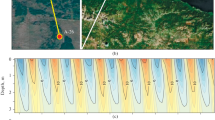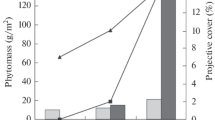Abstract
Temperatures of sandy podzols of middle taiga pine forests with moss and lichen ground cover were analyzed which had been exposed to ground fires of low to medium intensity. In general, temperatures in lichen and moss plots of the pine forests under study, are close to each similar, but in the first year after a fire a noticeable contrast was observed. The reasons are an increase in the amplitude of daily temperatures on the soil surface and stronger heating of upper mineral layers. Temperatures in the mineral layer with depths up to 30 cm depend on the thickness of the forest floor. Analysis of the results show that the duration of post-fire effects in pine forests with sandy podzols is determined by a number of factors: the intensity of the fire, the degree of erosion of the ground cover and litter, and the recovery rate of these components.




Similar content being viewed by others
References
Allison SD, McGuire KL, Treseder KK (2010) Resistance of microbial and soil properties to warming treatment seven years after boreal fire. Soil Biol Biochem 42(10):1872–1878
Baldock JA, Smernik RJ (2002) Chemical composition and bioavailability of thermally altered Pinus resinosa (red pine) wood. Org Geochem 33(9):1093–1109
Bekhovykh Yu V (2002) Influence of the forest fires on the hydrothermal regime of the soddy podzolic soils of the dry steppe zone of the Altai Krai. In: Bekhovykh Yu V (ed) Anthropogenic influence on the forest ecosystems: theses of reports of II International Confernce (18–19 April, 2002). Altai University Publishing, Barnaul, pp 139–142
Bezkorovaynaya I, Ivanova G, Prokushkin A, Evgrafova S, Klimchenko A, Tarasov P, Solnyshkin I (2015) Dynamics of soil properties after forest fires in boreal zone of Central Siberian ecosystem (Russia). Flamma 2:81–85
Bezkorovaynaya IN, Ivanova GA, Tarasov PA, Sorokin ND, Bogorodskaya AV, Ivanov VA, Macrae DD (2005) Pyrogenic transformation of soils of middle taiga pine forests of Krasnoyarsk Krai. Sib Ecol J 1:143–152
Bezkorovaynaya IN, Tarasov PA, Ivanova GA, Bogorodskaya AV, Krasnoschekova EN (2007) Nitrogen stock of sandy podzols after controlled burning of middle Siberian pine forests. Soil Sci 6:775–783
Bodí MB, Martin DA, Balfour VN, Santín C, Doerr SH, Pereira P, Cerdà A, Mataix-Solera J (2014) Wildland fire ash: production, composition and eco-hydro-geomorphic effects. Earth Sci Rev 130:103–127
Cerdà A, Doerr SH (2008) The effect of ash and needle cover on surface runoff and erosion in the immediate post-fire period. CATENA 74(3):256–263
Certini G (2005) Effects of fire on properties of forest soils: a review. Oecologia 143(1):1–10
Certini G (2014) Fire as a soil-forming factor. Ambio 43(2):191–195
Conard SG, Ivanova GA (1997) Wildfire in Russian boreal forests—potential impacts of fire regime characteristics on emissions and global carbon balance estimates. Environ Pollut 98(3):305–315
Deviatova TA, Gorbunova YS, Rumyantseva IV (2019) Basic property analysis of sod-forest soil covered by a forest fire in the territory of Usmansky pinery (RF). IOP Conference Series: Earth and Environmental Science. IOP Publishing, 392(1):012048
Dymov AA, Abakumov EV, Bezkorovaynaya IN, Prokushkin AS, Kuzyakov YV, Milanovsky EY (2018) Impact of forest fire on soil properties. Theor Appl Ecol 4:13–23
Evdokimenko MD (1979) Microclimate of tree stands and hydrothermal regime of soils in the pine forests of Transbaikalia after the ground fires. Burning and fires in the forest: Collection of articles. Institute of Forest and Wood, Krasnoyarsk, pp 130–140
Furyaev VV (1996) The role of fires in the forest formation process, Scientific edn. Nauka, Novosibirsk, p 253
Gael AG, Smirnova LF (1999) Sands and sandy soils. GEOS, Moscow, p 252
Guénon R, Vennetier M, Dupuy N, Roussos S, Pailler A, Gros R (2013) Trends in recovery of mediterranean soil chemical properties and microbial activities after infrequent and frequent wildfires. Land Degrad Dev 24(2):115–128
Ketterings QM, Bigham JM, Laperche V (2000) Changes in soil mineralogy and texture caused by slash-and-burn fires in Sumatra, Indonesia. Soil Sci Soc Am J 64:1108–1117
Kovaleva NM, Ivanova GA (2013) Restoration of the living ground cover at the initial stage of the pyrogenic succession. Sib Ecol J 20(2):203–213
Krasnoshchekov YuN, Cherednikova YuS (2012) Post-pirogenic transformation of the cedar forests soils in the southern Baikal region. Soil Sci 10:1057–1067
Loupian EA, Mazurov AA, Flitman EV, Ershov DV, Korovin GN, Novik VP, Tatarnikov AV (2006) Satellite monitoring of forest fires in Russia at federal and regional levels. Mitig Adapt Strat Glob Change 11:113–145
Mataix-Solera J, Cerdā A, Arcenegui V, Jordán A, Zavala LM (2011) Fire effects on soil aggregation: a review. Earth Sci Rev 109(1–2):44–60
Pereira P, Ubeda X, Mataix-Solera J, Martin D, Oliva M, Novara A (2013) Short-term spatio-temporal spring grassland fire effects on soil colour, organic matter and water repellency in Lithuania. Solid Earth Discussions 5(2):2119–2154
Ponomaryov E, Kharuk V (2016) Wildfire occurrence in forests of the Altai-Sayan region under current climate changes. Sib Ecol J 1:38–46
Ponomaryov E, Ponomaryova T, Masyagina O, Shvetsov E, Ponomaryov O, Krasnoshchekov K, Dergunov A (2019) Post-Fire effect modeling for the permafrost zone in central Siberia on the basis of remote sensing data. In: Multidisciplinary Digital Publishing Institute Proceedings. vol 18, No. 1, p 6
Prokushkin SG, Abaimov AP, Prokushkin AS, Kaverzina LN (2002) Nitrogen nutrition of the larch trees on the permafrost soils. Sib Ecol J 2:203–211
Santana VM, Bradstock RA, Ooi MK, Denham AJ, Auld TD, Baeza MJ (2010) Effects of soil temperature regimes after fire on seed dormancy and germination in six Australian Fabaceae species. Aust J Bot 58(7):539–545
Sharrow SH, Wright HA (1977) Effects of fire, ash, and litter on soil nitrate, temperature, moisture and Tobosa-grass production in the rolling plains. J Range Manag 30(4):266–270
Smits KM, Kirby E, Massman WJ, Baggett LS (2016) Experimental and modeling study of forest fire effect on soil thermal conductivity. Pedosphere 26(4):462–473
Tarasov PA, Ivanov VA, Ivanova GA, Krasnoschekova EN (2011) Post-pyrogenic changes in hydrothermal parameters of soils of middle Taiga pine forests. Soil Sci 7:795–803
Tsibart AS, Gennadiev AN (2008) The influence of fires on the properties of forest soils in the Amur River basin (the Norskii Reserve). Eurasian Soil Sci 41(7):686–693
Ulery AL, Graham RC (1993) Forest fire effects on soil color and texture. Soil Sci Soc Am J 57:135–140
Valendik EN (1995) Large forest fires in Siberia. Geogr Nat Resour 1:85–92
Vermeire LT, Wester DB, Mitchell RB, Fuhlendorf SD (2005) Fire and grazing effects on wind erosion, soil water content, and soil temperature. J Environ Qual 34(5):1559–1565
Acknowledgements
The research was supported financially by the Russian Foundation for Basic Research, the Government of Krasnoyarsk Krai, and the Krasnoyarsk Regional Foundation for Science as a part of the scientific Project No. 18-44-243007 “Evaluation of stress proteins content and photosynthesis intensity of the pine needles (Pinus Sylvestris) in the post-pyrogenic period in the Krasnoyarsk forest-steppe”; Grant of the East Siberian Oil and Gas Company aimed at supporting scientific research of applied importance in 2020.
Author information
Authors and Affiliations
Corresponding author
Additional information
Publisher's Note
Springer Nature remains neutral with regard to jurisdictional claims in published maps and institutional affiliations.
Project funding: The research was supported financially by the Russian Foundation for Basic Research, the Government of Krasnoyarsk Krai, and the Krasnoyarsk Regional Foundation for Science as a part of the scientific Project No. 18-44-243007 “Evaluation of stress proteins content and photosynthesis intensity of the pine needles (Pinus Sylvestris) in the post-pyrogenic period in the Krasnoyarsk forest-steppe”; Grant of the East Siberian Oil and Gas Company aimed at supporting scientific research of applied importance in 2020.
The online version is available at http://www.springerlink.com.
Corresponding editor: Yu Lei.
Rights and permissions
About this article
Cite this article
Bezkorovaynaya, I.N., Tarasov, P.A., Gette, I.G. et al. Influence of fire on soil temperatures of pine forests of the middle taiga, central Siberia, Russia. J. For. Res. 32, 1139–1145 (2021). https://doi.org/10.1007/s11676-020-01186-8
Received:
Accepted:
Published:
Issue Date:
DOI: https://doi.org/10.1007/s11676-020-01186-8




